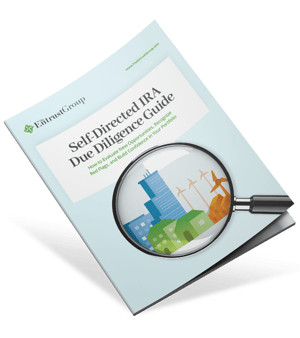Self Directed IRA for Real Estate: Benefits, Risks, & Next Steps

Estimated reading time: 5 minutes
Table of Contents
Introduction
Many IRAs are based in investments like stocks, bonds, and mutual funds. Self-directed IRAs (SDIRAs), however, empower investors to grow their retirement accounts with alternative assets such as private equity, private placements, precious metals, and of course, real estate.
In this article, we’ll give you a detailed look at how you can leverage self directed IRAs to invest in real estate. This type of IRA is often referred to as a "Real Estate IRA".
We’ll cover the Real Estate IRA process: from account types to purchasing strategies and everything in between.
Then we’ll provide a list of the paperwork and steps to take to hold real estate in your individual retirement account.
Finally, we’ll wrap it up with key points to keep in mind if you invest in a rental property with your self directed account.
You’ll also find an FAQ on the top real estate investing questions we receive at the bottom of this article.
_______________
KEY TAKEAWAYS
With a self-directed IRA you can use retirement funds to invest in real estate in a tax-advantaged manner. This is also known as a "Real Estate IRA".
Self-directed IRA real estate investing can be carried out through direct purchases, partnered funds, an LLC, or with a non-recourse loan.
Your SDIRA owns the investment property, and all related income and expenses must flow through the SDIRA.
_______________
How a Self-Directed IRA for Real Estate Works
When you buy real estate through your individual retirement accounts, you can invest in any type of real estate. This includes rental properties, raw land, and even commercial properties. You can also invest through real estate investment trusts (REITs) or by issuing a mortgage note.
5 Steps to investing in Real Estate with an SDIRA. Get your free copy now >
How to Invest in Real Estate Using a Self-Directed IRA
The process for investing in physical real estate as an IRA investment is very similar to a regular real estate purchase, but there are a few important differences. Here's how to buy real estate assets in a self-directed IRA.
1. Begin the Process
Open a Real Estate IRA
Before finding a property, make sure you have your self-directed retirement account set up. We make it easy for you to set up your account online in just a few minutes. Once opened and funded, you are ready to begin your journey to alternative investments.
Choose your self directed retirement account
Real estate investors can purchase real estate through several types of self-directed accounts, including a traditional IRA, Roth IRA, or Individual 401(k).
-
Traditional IRAs are funded with pre-tax dollars, meaning you don’t pay taxes until you take distributions. This type of account is often used by investors who anticipate their tax rate will be lower when they distribute the asset.
-
Roth IRAs are funded with post-tax dollars, and assets can be distributed tax-free after age 59 ½ if the account is over five years old.
-
Individual 401(k)s are a retirement plan available to small business owners who do not have employees (other than a spouse or business partner). They're funded with pre-tax dollars and distributed tax-deferred like a traditional IRA. This account also has some advantages for real estate investing.
Unsure of which account is right for you? Contact your IRA custodian for a more detailed explanation of the tax advantages of each.
Fund Your New Account
There are three ways to fund your self directed IRA, many of which involve accounts you already have with another financial institution:
-
Transfer funds from one account to another account that is the same type (e.g., transfer from an old IRA to a self-directed IRA)
-
Rollover funds between different types of accounts (e.g., rollover funds from a previous employer’s 401(k) into an SDIRA)
-
Annual contributions in accordance with the contribution limits set by the IRS each year.
To better understand each method, download your copy of our SDIRA Funding Guide.

Learn the Real Estate IRA Rules and Regulations
Be sure you know the rules and regulations for investing in real estate with an SDIRA. Read about prohibited transactions and disqualified persons to make sure you invest and manage your account according to IRS rules. Doing so can help to protect your retirement savings by maintaining the account's tax-advantaged status.
One common question we receive is if an investment property with an IRA owner can also be used for personal use. The answer is no. Anyone considered a "disqualified person" may not personally benefit from a property owned by the IRA. Examples of disqualified persons include: your spouse, parents, children, and any service providers of the IRA, like your IRA custodian.
Another important rule to consider is because your self directed IRA owns the property, all income and expenses must flow through it. As an IRA owner, it is crucial to keep these rules in mind.
Do Your Due Diligence
Many investors get excited about the prospect of adding alternative assets to their traditional or Roth IRA. Download our Self-Directed IRA Due Diligence Guide for a list of questions to ask first.

Self-Directed IRA Due Diligence Guide
2. How to Invest in Real Estate Using a Self-Directed IRA
There are five common real estate investment strategies you can follow using your retirement savings. Regardless of which path you choose, holding these alternative investments in your retirement account can have tax advantages over buying real estate with personal funds.
Direct Purchase Real Estate with Cash
Your newly-funded SDIRA can purchase the property outright if it holds sufficient cash, which is known as a direct purchase. If your SDIRA doesn't have enough funds for a direct purchase, you have other options.
Partner Your Funds
Team up with other IRAs, your personal funds, or personal funds from other investors. Your SDIRA can partner with anyone for the initial purchase, including your own personal cash. After the transaction is complete, the IRA cannot conduct any business with a disqualified person. Ownership, expenses, and profits are divided in proportion to each investor’s contribution to the real estate assets.
Use a Non-Recourse Loan
For your real estate investments to be owned by your SDIRA, you cannot use a mortgage based on your personal credit. Instead, you can use a non-recourse loan, which ensures that if your IRA defaults, the lender’s only recourse is to foreclose upon the real estate used as collateral.
LLC
Though an LLC generally takes more effort to establish, it has a few key benefits. Checkbook control makes you less reliant on your IRA custodian. The funds deposited into your LLC’s checking account are readily available. Your transactions become as simple as writing a check. It also allows you to purchase and sell the LLC’s investments without involving your SDIRA provider, saving you money and time.
Mortgage Notes
These are promissory notes used exclusively in real estate transactions. They represent a borrower's promise to pay the holder. Mortgage notes can be secured or unsecured and are often seen as a way to invest in real estate without being a landlord.
If you are a new real estate investor, you might explore a number of different real estate assets in order to find the one that best matches your industry knowledge. You can use this experience to find investment options that better suit your goals, while also enjoying the tax benefits of an IRA investment.
3. Purchase a Property
Find a Property and Make an Offer
This is the exciting part when you find an investment for your SDIRA. Make sure the contract is titled with your SDIRA as the buyer. For example, “The Entrust Group FBO Client Name Account X #555555.” Entrust signs the purchase contract and you sign as “read and approved.”

Once Your Offer is Accepted
Your SDIRA provider wires your earnest money deposit (EMD) to the title company after receiving the fully executed Purchase Contract agreement and the Buy Direction Letter form.
Upon receipt of the fully executed Purchase Contract agreement, your SDIRA provider funds your EMD, if applicable. At this point, you can begin any inspections or appraisals. You'll also need your SDIRA provider to send money to cover expenses for any inspections.
Open Escrow
Once escrow has opened, you'll need these documents:
-
Warranty Deed or Grant Deed
-
Title Insurance Commitment or Preliminary Title Report (provide closing instructions)
-
Settlement or Closing Statement
-
Title Company Wiring Instructions
-
Escrow Closing Instructions (if applicable)
-
Loan Documents (if applicable)
-
Seller’s Entity Formation Documents (if applicable)
-
Any closing documents buyer is required to sign at closing (other than listed above)
Closing Escrow
After inspection and once you've satisfied any contingencies, you're ready to close. After submitting the documents listed above, your SDIRA provider reviews the paperwork and funds the remaining balance.
Congratulations! Your self directed IRA now owns real estate.
Renting Your Property
Once the purchase is complete, you can move forward with interviewing potential tenants. Remember to follow all rental laws in the Fair Housing Act when selecting tenants.
For a long-term tenant, you'll need to create a rental agreement. Your IRA custodian will sign the rental agreement on behalf of the SDIRA. All rental payments must be paid to the self directed IRA.
Benefits of Self-Directed IRAs for Real Estate
Some benefits of buying real estate in your retirement account include:
-
Potential for higher returns than traditional investment options
-
Protecting your retirement savings from economic fluctuations and volatility
-
Tax free or tax deferred growth, providing certain conditions are met
-
Increase your retirement income through rental properties
This asset can generate significant cash flow and capital appreciation for your SDIRA. Plus, if you’re analytically-minded and have real estate expertise, you may be able to spot a diamond in the rough better than the competition.
Potential Risks of Self-Directed IRAs for Real Estate
Investment properties are subject to fluctuations in the real estate market. Be sure to do your due diligence when considering any market and its potential for growth. And remember: even if you do everything right, there's no guarantee that an investment will pay off. Some factors that could play into a bad investment include:
-
Poor location
-
Negative cash flows
-
High vacancies
-
Problem tenants
-
Unexpected repairs or increased maintenance needs
-
Extreme weather, like hurricanes or tornados
It's also important to remember real estate is not a liquid investment. It can take time to sell the property and convert it to cash. It's also possible that you may have to sell a property at a loss.

Next Steps for Investors
Since 1975, IRAs have been a popular tax-advantaged strategy for investors saving for retirement. For over 40 years, The Entrust Group has been making it possible for investors to self-direct their accounts.
Want to learn more about purchasing a property with an IRA? Download our step-by-step guide to investing in real estate with a self-directed IRA.
Got an investment in mind already? It takes just 10 minutes to open a self-directed IRA online or schedule a call with our knowledgeable staff to answer any questions you may have.
FAQs: Real Estate Investments & SDIRAs
Can I personally use the property purchased with my SDIRA funds?
No. You cannot personally use a property you have purchased with your SDIRA. Learn about the rules and regulations for buying an investment property with your self directed account.
Can I rent the property to my family?
Most likely not. You cannot rent the property to any disqualified persons. Learn who is a disqualified person to make sure you protect the tax-advantaged status of your SDIRA.
Can I act as property manager for my investment property?
While you can technically be the property manager, as a disqualified person, you cannot benefit from the investment nor collect any rent payments directly. For many investors, the SDIRA hires and pays a property manager to avoid possible prohibited transactions.
Do expenses such as utilities, repairs, taxes, and mortgage payments need to be paid by the SDIRA?
Yes. All expenses for the investment property must be paid with funds held by the SDIRA. Remember the SDIRA is the owner of the real estate investment.
Can the rental income from the property in my IRA be sent to me personally?
No. The SDIRA is the owner of the property, so all rental income must be paid to the SDIRA.
What are the rules for selling the property?
Selling a real estate asset in your retirement plan is similar to a regular real estate transaction. The key difference is The Entrust Group handles and signs all of the documents on behalf of your SDIRA.
Disclaimer: None of the above is investment advice. All IRA investments have risk and investment decisions should be made with the help with an experienced professional or financial advisor. IRA custodians can provide personalized service, but they cannot provide investment advice.




























7 Comments